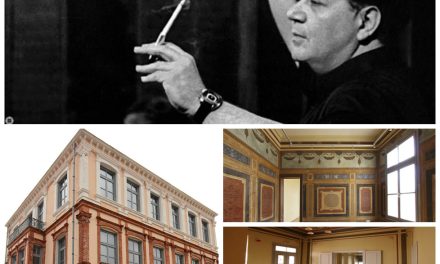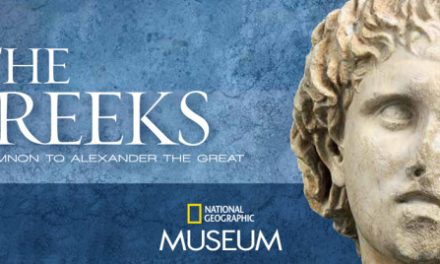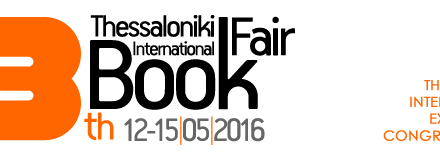Medicine, one of the sciences of greatest importance for the survival of humankind, has evolved over thousands of years in various parts of the world; initially intertwined with superstition, magic and supernatural beliefs, it has slowly moved away from the realm of myth and theurgy and into the field of rationality, observation, experimentation and what we have come to consider a scientific way of thinking.
As illnesses and trauma have always been part of human existence, multiple approaches to healing were developed in various parts of the world. Mesopotamia, Egypt and Chine are among the places were the first forms of systematic medical treatment appeared. Ancient Greece and, later, the Byzantine Empire greatly contributed to the evolution of medicine, and its transformation into a concrete science, thanks to important figures, discoveries and advancements that shaped the course of medical history.
Rationalisation of medicine
All civilisations initially attributed supernatural origins to ailments and disease. The teachings of the Pre-Socratic philosophers (6th c. BC) served as the foundation for rational scientific medicine, challenging the divine provenance of disease and dissociating treatment from divine intervention.
As James Longrigg states in his book Greek Rational Medicine: Philosophy and Medicine from Alcmaeon to the Alexandrians that “one of the most impressive contributions of the ancient Greeks to Western culture was their invention of rational medicine. It was the Greeks who first evolved rational systems of medicine for the most part free from magical and religious elements and based upon natural causes”. Longrigg adds that this “transition from mythological conjecture to rational explanation” was the outcome of “precisely the same attitude of mind which the Milesian natural philosophers had been the first to apply to the world about them”.
One of the Pre-Socratics who contributed most to this was Alcmaeon of Croton, medical writer and philosopher-scientist. Croton was a major Greek colony in Southern Italy (Magna Graecia) and, in the second half of the sixth century, home to physicians who Herodotus praised as the best in the Greek world. While accepting the superiority of divine -compared to human- knowledge, Alcmaeon believed that people could gain knowledge about the perceptible world, by making reasonable judgments from the signs that are presented to them by sensation; he thus rejected the claims of those who base their account of the world on the certainty of a divine revelation.
Alcmaeon is also the first to argue that the brain is the central organ of sensation and thought. He also developed the theory that all senses are connected to the brain, through channels (poroi) linking sensory organs with the brain. He is thought to have come to this conclusion after the excision of a dead animal’s eye and the observation of its optic nerves. He was also likely the first one to introduce the idea that a person’s health depends on a balance of opposed factors in the body.
One of the most famous physicians of Croton in the 6th c. was Democedes, who was captured by the Persians and served as a slave in the court of Darius the Great. He was held in high regard for having been the only one able to heal king Darius dislocated ankle after an accident. He later cured the king’s wife, Atossa, from a health problem, speculated by contemporary scientists to be the first recorded case of inflammatory mastitis.
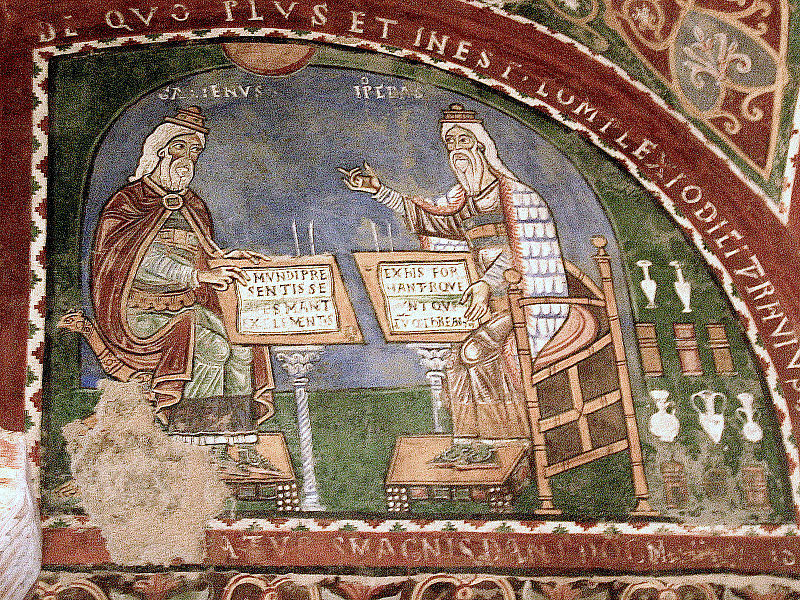 Mural painting showing Galen and Hippocrates. 12th century; Anagni, Italy (via Wikimedia Commons)
Mural painting showing Galen and Hippocrates. 12th century; Anagni, Italy (via Wikimedia Commons)
Hippocratic School of Medicine
Hippocrates of Kos is considered to have been the “Father of Modern Medicine”. He lived in the Classical period and established a medical school on his home island. Hippocrates and his students have left behind a collection of around 60 medical works that has come to be known as the Hippocratic Corpus, where a number of illnesses and treatments are documented; it features textbooks, lectures, research, notes and philosophical essays on various subjects in medicine.
In the Hippocratic Corpus we encounter a firm rejection of the supernatural causes previously ascribed to illnesses; this is clearly illustrated in the treatise On the Sacred Disease, which deals with epilepsy, a condition traditionally regarded as the result of supernatural or divine agency by people throughout the ancient world – hence its Greek name “the sacred disease”. The (unconfirmed) author of the work blatantly disparages such views, and states that it instead “has a natural cause, and its supposed divine origin is due to men’s inexperience and to their wonder at its peculiar character”.
Hippocrates espoused the theory of humourism, a version of which had first been developed by Alcmaeon in his idea of balance which he named “equality (isonomia)”. For Hippocrates, the health of the human body depended on the balance between vital bodily fluids known as “humours”, namely blood, yellow bile, phlegm and “black bile”. The imbalance of humors, or dyscrasia, was thought to be the direct cause of all diseases.
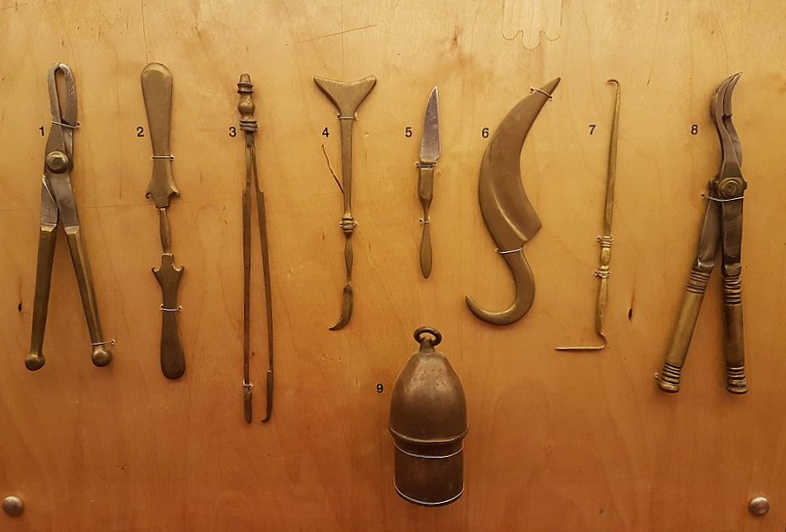 Surgical tools, 5th century BC, Greece. Reconstruction based on descriptions within the Hippocratic corpus. Thessaloniki Technology Museum (by Gts-tg via Wikimedia Commons)
Surgical tools, 5th century BC, Greece. Reconstruction based on descriptions within the Hippocratic corpus. Thessaloniki Technology Museum (by Gts-tg via Wikimedia Commons)
Great importance was also placed on the role of the environment, which was also believed to influence the balance of these fluids. Great emphasis was put by Hippocrates on the importance of a person’s general lifestyle as a health factor; this included maintaining personal hygiene, eating, drinking, sleeping and exercising with moderation etc.
From Hippocrates onward, the humoral theory was adopted by Greek, Roman and Islamic physicians, and dominated the view of the human body among European physicians until the 16th c. Although those theories were obviously erroneous, they constituted a step towards the right direction, that of identifying the causes of illness as results of internal problems or symptoms of environmental causes, rather than supernatural and magical ones.
The Hippocratic Corpus also contains the famed Hippocratic Oath for physicians, which is still regarded as the basis for ethical issues in medicine. Another important contribution of Hippocratic medicine was its recognition of the antiseptic properties of wine, oil, and vinegar, and the use of wine and vinegar in the dressing of wounds.
Anatomy
Until the Hellenistic times, dissecting a human cadaver was regarded as taboo. But in the turn of the 3rd c. BC, in Hellenistic Alexandria, took place some of the most striking advances in early anatomy and physiology, thanks in large part to Herophilus of Chalcedon and Erasistratus of Ceos, who helped pioneer human dissection for medical research.
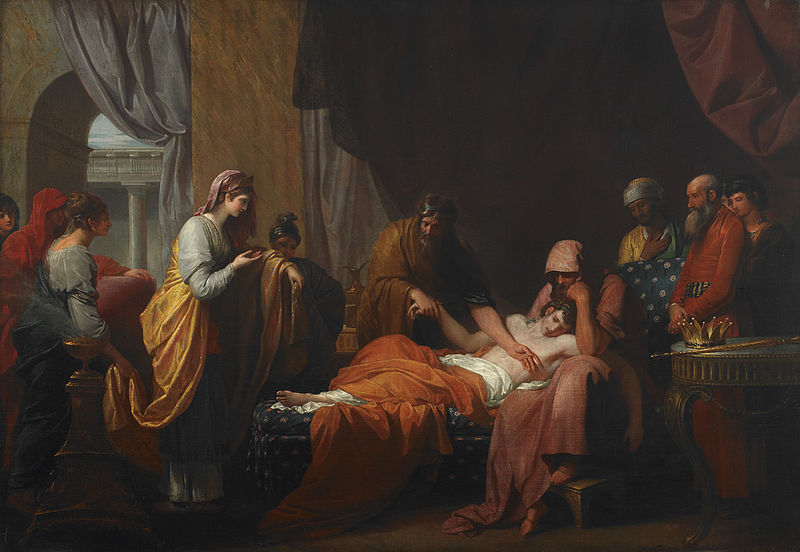 Benjamin West, Erasistratus the Physician Discovers the Love of Antiochus for Stratonice, 1772
Benjamin West, Erasistratus the Physician Discovers the Love of Antiochus for Stratonice, 1772
Herophilus became known for his anatomical works making impressing contributions to many branches of anatomy and many other aspects of medicine. His knowledge of the human body provided vital input towards understanding the brain, eye, liver, reproductive organs and nervous system, and characterising the course of disease. He gained a deep understanding of the human respiratory, circulatory, reproductive and digestive systems, and accurately described the various parts of the brain, as well as the function of the motor nerves.
Erasistratus as well wrote many works on anatomy, practical medicine and pharmacy, which attest to his great knowledge regarding the function of the human organs, as in the case of his observations on the morphology of the heart and his discovery of the functioning of its four main valves. He also accurately described the structure of the brain, including the cavities and membranes, and made a distinction between its cerebrum and cerebellum.
Hippocrates and the Alexandrian physicians were a great influence on Galen, a prominent Greek physician and philosopher from the Hellenistic city of Pergamon, who earned great recognition in the Roman Empire in the 2nd c. AD. He was an accomplished anatomist, although his reports were based on the dissection and vivisection of animals, since human dissection was strictly prohibited at the time. In his time, Galen’s reputation as both physician and philosopher was legendary. He summarised and synthesised the work of his predecessors, and it is in Galen’s words (Galenism) that Greek medicine was handed down to subsequent generations His theory of the physiology of the circulatory system remained unchallenged until the 13th c., and his anatomical reports remained uncontested until the 16th c.
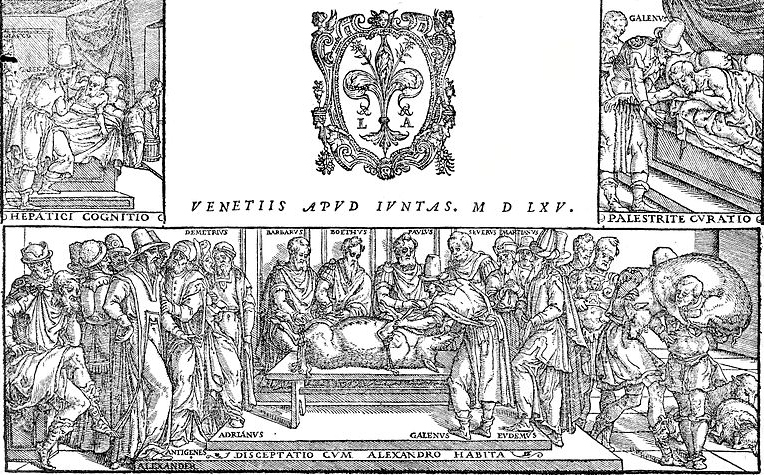 Galen, Opera omnia, dissection of a pig, 1565 (via Wikimedia Commons)
Galen, Opera omnia, dissection of a pig, 1565 (via Wikimedia Commons)
Byzantine Hospitals
In an extensive survey of hospitals in the East Roman Empire (The Birth of the Hospital in the Byzantine Empire), Timothy Miller challenges the view that modern hospitals emerged during the latter half of the nineteenth century; he traces the birth and development of Byzantine xenones, or hospitals, from their emergence in the fourth century to their decline in the fifteenth century, just prior to the Turkish conquest of Constantinople. These sophisticated medical facilities, he concludes, are the true ancestors of modern hospitals. In a new introduction to this paperback edition, Miller describes the growing scholarship on this subject in recent years.
The first hospital was erected by Leontius of Antioch between the years 344 to 358 and was a place for strangers and migrants to find refuge. In his Chronographia, Michael Psellos describes emperors Basil I, Romanos I Lekapenos, and Constantine IX building new hospitals. Although the remains of these hospitals have not been discovered by archaeologists, recordings of hospitals from the Byzantine Empire describe large buildings that had the core feature of an open hearth. The establishments of the Byzantine Empire resembled the beginning of what we now know as modern hospitals.
Surgery
A recent research from Adelphi University has revealed “the first forensically-assessed archeological discovery of remains” of a group of mounted archer-lancers and their kin from the ProtoByzantine period (4th-7th c. AD), which bear evidence of a complex form of brain surgery. Ten skeletal remains—four women and six men likely of high social standing—were discovered in the Paliokastro site on Thasos island in Greece.
According to lead researcher and anthropologist Anagnostis Agelarakis, Ph.D., professor of anthropology in Adelphi’s Department of History, “The very serious trauma cases sustained by both males and females had been treated surgically or orthopedically by a very experienced physician/surgeon with great training in trauma care”. One male skeleton, believed to have belonged to a person of very high status in the region, carried evidence of an “extraordinary head and neck surgery” that should have taken great effort from the part of the surgeon.
“The surgical operation is the most complex I have ever seen in my 40 years of working with anthropological materials,” Agelarakis said. “It is unbelievable that it was carried out, with most complicated preparations for the intervention, and then the surgical operation itself which took place, of course, in a pre-antibiotic era.”
One especially renowned surgeon was Paul of Aegina, a Byzantine Greek physician of the 7th c. AD, best known for writing the medical encyclopedia Medical Compendium in Seven Books, the most complete work of its time. Although Byzantine medicine drew largely on ancient Greek and Roman knowledge, however, his works also contained many new ideas.
The most notable part of Paul’s treatise is book 6, which is exclusively devoted to surgery and became the most influential source on the subject throughout the Byzantine period. It references over forty types of surgery -e.g. the operation to fix a hernia- and around fifteen surgical instruments. In his description of the surgical methods, Paul provides a step-by-step, specialised, and detailed process to be followed by physicians, while also offering recommendations for postoperative care. In his opinion, physicians needed to have practical manuals that they could carry everywhere for immediate consultation.
An important testimony regarding the application of surgical methods in the Byzantine Empire is the typikon of the xenon (hospital) of the Pantokrator Monastery, in the 11th c. It mentions the responsibilities of the akonetes (sharpener), whose job it was to keep all the surgical instruments used by the physicians clean. It also it refers to lancets, cauterizing irons, a catheter and dental forceps.
Separation of conjoined twins
One particularly interesting case of medically advanced techniques used in the Byzantine Empire is that of the first recorded separation of conjoined twins, which took place in the 10th century AD. One of the conjoined twins had already died, so surgeons attempted to separate the dead twin from the surviving twin. The result was partly successful as the remaining twin lived for three days after separation. The next case of separating conjoined twins was recorded in 1689 in Germany several centuries later.
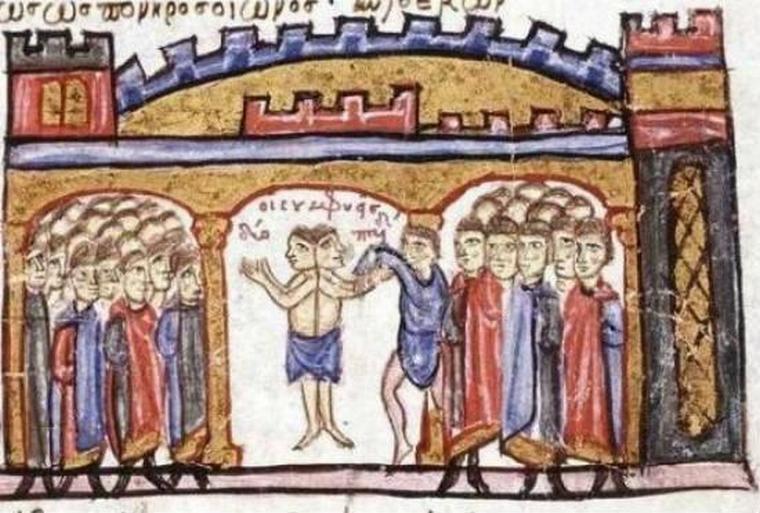 Illustration depicting the separation of the twins, from Ioannes Scylitzes’ The Synopsis of Histories
Illustration depicting the separation of the twins, from Ioannes Scylitzes’ The Synopsis of Histories
The story of the conjoined male twins was documented in several chronicles of the time; they were born in Armenia, and were generally able-bodied, but, according to the History of Leo the Deacon, “their sides were attached from the armpit to the hip”. They roamed the Byzantine Empire to make a livelihood as a curiosity display. At some point during the reign of Constantine VII Flavius Porphyrogenitus (944-59), the twins were living in Constantinople, and one of them lost his life.
As is documented in the Theophanes Continuatus chronicle, as well as in Ioannes Scylitzes’ The Synopsis of Histories, upon the death of one twin, doctors performed a surgery on the twins to separate them. The operation was in fact successful, as the living twin was separated and did manage to survive, if only for three more days. Scylitzes’ account, which was written in the 11th century, also features three illustrations depicting the surgery.
Nefeli Mosaidi (Introimage: Anne-Louis Girodet de Roussy-Trioson, Hippocrates refusing the gifts of Artaxerxes, 1792)
Sources
James Longrigg, Greek Rational Medicine: Philosophy and Medicine from Alcmaeon to the Alexandrians (Taylor & Francis Ltd, 1993)
Hayat Kısa, Sanat Uzun Life Is Short, Art Long. The Art of Healing in Byzantium (King’s College London, 2018)
Hymn to Hygieia: Health, Illness, Treatment from Homer to Galen (Museum of Cycladic Art)
Timothy Miller, The Birth of the Hospital in the Byzantine Empire, Johns Hopkins University Press, 1997
Researcher discovers early, complex brain surgery in ancient Greece (Adelphi University, Phys.org)
The Case of Conjoined Twins in 10th Century Byzantium (Medievalists.net)
Stanford Encyclopedia of Philosophy
Ancient Greek medicine, Byzantine Medicine (Wikipedia)
Read also via Greek News Agenda: Greek words about health and medicine in English; The Plague of Athens as told by Thucydides: a timeless analysis of an epidemic; Epidemiology and international cooperation in early 20th century Greece
TAGS: ARCHEOLOGY | HISTORY | SCIENCE

